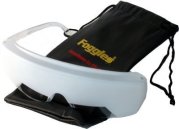It’s come time for my 6-month club checkout flight with a CFI — and, incidentally, next month was the expiration date for my flight review, so I decided to just combine the two and scheduled a morning with one of our club’s instructors.
We met early in the morning, and spent an hour on questions about FARs. The instructor had a list of about 40 questions, ranging from fairly straightforward checkride-like ones (“what causes a stall? what are the entry requirements into a Class B airpsace?”) to trickier ones that were either exceptions to the general rule worth remembering, or something not clearly specified and thus requiring discussion. I didn’t know what to expect — this being my first flight review — but I enjoyed the session quite a bit. It was at once a refresher on some topics that I haven’t thought about in a while, as well as a chance to learn a few things in some of those tricky areas.
We then took off from Hawthorne and headed off to do some air work. On takeoff we flew towards Torrance and the instructor handed me a pair of foggles.  I think it’s been a full two years since I’ve worn a view-limiting device, so it was actually pretty challenging to transition into flying on instruments alone. The instructor gave me some heading changes, and we flew like that for a number of minutes. I think that this is probably one of the better aspects of the flight review: a low-pressure but forced instruction on a variety of topics you may be out of practice on.
I think it’s been a full two years since I’ve worn a view-limiting device, so it was actually pretty challenging to transition into flying on instruments alone. The instructor gave me some heading changes, and we flew like that for a number of minutes. I think that this is probably one of the better aspects of the flight review: a low-pressure but forced instruction on a variety of topics you may be out of practice on.
The instructor then had me do slow flight in a clean configuration, something that I rarely do (I show off slow flight to my friends from time to time, both to show that a plane can fly slow as well as to practice slow flight, but I always do it with flaps down). A power-off stall came next, and I kept power in for so long that it made the plane hard to stall. Then some steep turns, which I do from time to time, followed by an emergency descent, which I practice so infrequently as to not remember how to set myself up right away. I should aim to practice this more often.
We then headed back, but the instructor set up a scenario for a simulated control cable break where the yoke became inoperable. I then proceeded to fly on throttle and rudder alone. While obviously the airplane normally has some amount of positive stability and allows you to take your hands away from the controls for a while, it was altogether a different thing to spent 10 minutes of flight without ailerons or an elevator, and have to go through altitude and heading changes. I’ve read before of people landing with controls inoperative and this scenario was a pretty good indication of how that could be possible. It’s now to say that yaw + power makes for a very smoothly controllable airplane, but between the dihedral wing and other factors, it can work in a pinch.
Came back to Hawthorne, did a full stop landing, then taxied back, did a mostly-soft-field takeoff, landed again, and called it done. Flight review good for another two years, and club checkout accomplished!
Some takeaways:
- Either get serious about a case for the Stratux, or get a real Stratus. It’s very helpful in the basin.
- Finish making my own printed checklist. Consider approach plate inserts instead of lamination.
- Develop a pre-takeoff checklist, especially to help with mixture, flaps, and trim after a taxi-back.
- Acquire an inflatable flotation device. They’re small and yet give you peace of mind over water. And there’s lots of water around LA.
- The second-to-last page of the Advisory Circular AC91-67 contains a useful flowchart to follow when determining if broken equipment should ground a flight or not.
Totals: 1.1 hr in C172.
[…] Flight Review and club checkout […]
LikeLike